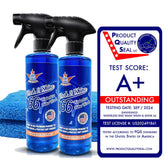The Truth About Ceramic Coatings: What You Need to Know
As someone who has developed and manufactured nano coatings and cleaning products for over 15 years across various industries—including automotive, concrete, wood, glass, and plastics—it's essential to clarify a common misconception surrounding ceramic coatings.

Understanding Ceramic Coatings
Many detailers promote their products as ceramic coatings, but it's important to note that there is no singular product that fits this definition. Typically, what you’ll find are coatings based on SiO2 (silicon dioxide) or newer technologies utilizing graphene, titanium oxide, and polymers.
It’s crucial to differentiate between authentic ceramic coatings and the so-called "spray coatings," which fail to form a true bond with the surface. The paint structure of a vehicle consists of three to five layers: primer, paint, and clear coat. Genuine ceramic coatings bond to the clear coat, providing essential protection against UV radiation, mechanical abrasion (like what occurs in car washes), and chemical damage.
Benefits of Ceramic Coatings
A well-formulated ceramic coating can significantly enhance the shine of your vehicle. This enhancement occurs through changes in light refraction and the incorporation of specialized polymers. While many ceramic coatings offer water-beading effects, it’s vital to recognize that all coatings will experience a fading effect over time due to abrasion. This wear occurs from actions like wiping with towels, using windshield wipers, and even exposure to small dust particles during driving. Thus, any claims from detailers regarding "self-cleaning" surfaces or the need to wash your vehicle less frequently are misleading.
That said, a high-quality ceramic coating can provide surface protection that lasts for months or even years, depending on the formulation. Some newer products refer to themselves as "glass coatings," but these also do not meet that standard.
SiO2 vs. Graphene Ceramic Coatings
When examining the materials used in ceramic coatings, SiO2 features a multi-level molecular structure that offers greater resistance to chemical impacts than abrasion. Typically, these coatings last anywhere from six months to two years, provided there are no significant impacts. In contrast, graphene-based ceramic coatings provide superior resistance to abrasion, making them more flexible and better suited for protecting clear coats. However, they may not perform as effectively against chemical damage, such as acids.
Why the Cost of Ceramic Coatings is Justified
The costs associated with ceramic coatings are often more about the preparation time required to ensure a flawless surface than the coating itself. Detailers invest significant time in removing scratches and swirls from the paint, clear coat, or chrome—this labor-intensive process is the primary driver of the expense.
The actual application of a quality ceramic coating can be straightforward and is suitable for DIY enthusiasts when using the right products. The application process may take only minutes, but curing can require up to 24-48 hours, with some coatings necessitating polishing afterward.
Making Informed Choices About Ceramic Coatings
When considering a ceramic coating, it’s crucial to ask about the ingredients used rather than focusing solely on the brand name. Regardless of marketing claims, most reputable ceramic coatings will be based on either SiO2 or graphene.
Be cautious of brands that import coatings from China and simply relabel them. Moreover, do not be swayed by coating sprays; these products are not true ceramic coatings. Often, they are water-based sprays that might contain silicone oil to create a visual water-beading effect but lack the protective qualities that authentic ceramic coatings provide against abrasion and UV radiation.



